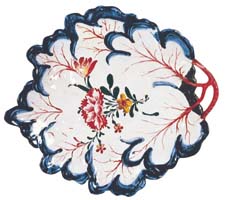Zuzana Francová
Since olden times people have used shapes and motifs taken from the nature to decorate objects of everyday as well as celebrative use. Plant motifs found a broader enforcement on ceramics, mainly on faience and porcelain. Two main directions were used in decorations: styled and naturalistic décor. A significant chapter in the history of faience in western Slovakia is connected to manufacture in Holíc, which was started before 1743 by the husband of Maria Theresia – Francis of Lotharingen. The characteristic décor is created by styled floral motifs in blue and naturalistic floral décor with a prevailing purple colour. Dominating the decorative motif is a purple rose as a result of a transformation of floral patterns from the Far East (mainly peony). A special part of Holíc production is vessels in naturalistic shapes, whose production has been recorded since 1753. Examples are chocolate boxes in the shape of a blooming rose, sets of plates and bowls in the shape of a veined leaf, vessels in the shape of a lemon, green cabbage heads of various sizes, asparagus, melon, pumpkin, pineapple and artichoke. Owing to the movement of craftsmen who had previously worked in Holíc, these products were copied in other folk workshops (mainly in Boleráz, Smolenice, Stupava, Castá and Dechtice). This effect was mutual. In the second half of the 19th century, competition between workshop products caused a continual fall in faience production in western Slovakia. The quality of the painted decoration was marked by assembly line production.
